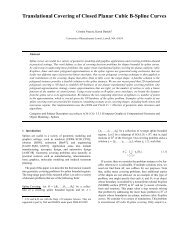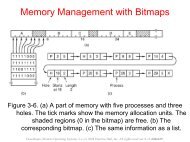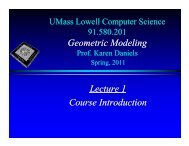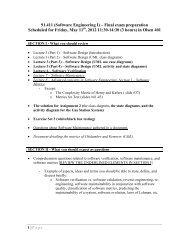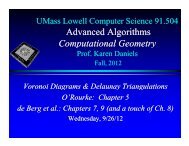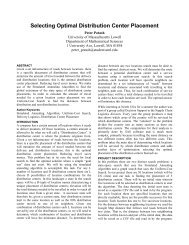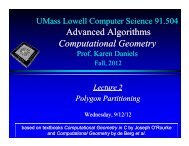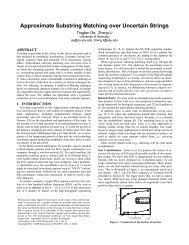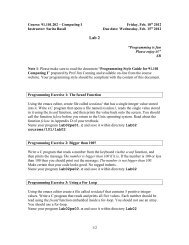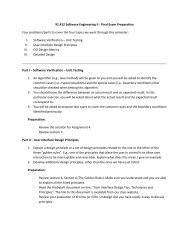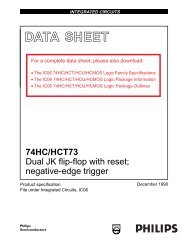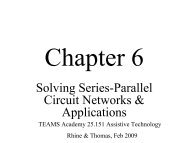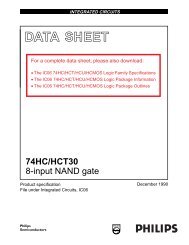Dr. Dobb's | It's Time to Get Good at Functional Programming ...
Dr. Dobb's | It's Time to Get Good at Functional Programming ...
Dr. Dobb's | It's Time to Get Good at Functional Programming ...
Create successful ePaper yourself
Turn your PDF publications into a flip-book with our unique Google optimized e-Paper software.
http://www.ddj.com/article/printableArticle.jhtml?articleID=212201710&dept_url=/development-<strong>to</strong>ols/<br />
<strong>It's</strong> <strong>Time</strong> <strong>to</strong> <strong>Get</strong> <strong>Good</strong> <strong>at</strong> <strong>Functional</strong> <strong>Programming</strong><br />
If you've been wondering wh<strong>at</strong> functional programming is all about, don't wait any longer. Michael<br />
examines functional languages like Scala, F#, Erlang, and Haskell, and Mike Riley adds a note<br />
about functional programming with M<strong>at</strong>hem<strong>at</strong>ica.<br />
By Michael Swaine, <strong>Dr</strong>. <strong>Dobb's</strong> Journal<br />
Dec 03, 2008<br />
URL:http://www.ddj.com/development-<strong>to</strong>ols/212201710<br />
We're approaching one of those paradigm shifts again. Knowledge of functional programming (FP) is on the<br />
verge of becoming a must-have skill. Now, we're not talking about a shift on the scale of the tec<strong>to</strong>nic movement<br />
th<strong>at</strong> object-oriented programming brought on. <strong>Functional</strong> programming has been around since the cre<strong>at</strong>ion of<br />
LISP in 1958 and hasn't taken over applic<strong>at</strong>ion development, nor is it about <strong>to</strong>. FP won't make your word<br />
processing program faster or better. But there are domains where it is highly useful, and in particular FP looks<br />
like the paradigm of choice for unlocking the power of multicore processors. <strong>Functional</strong> programming languages<br />
are ideally suited <strong>to</strong>, as one developer succinctly puts it, "solving the multicore problem."<br />
Which is a big deal, because the chipmakers have essentially said th<strong>at</strong> the job of enforcing Moore's Law is now a<br />
software problem. They will concentr<strong>at</strong>e on putting more and more cores on a die, and it's up <strong>to</strong> you <strong>to</strong> recraft<br />
your software <strong>to</strong> take advantage of the parallel-processing capabilities of their chips.<br />
And th<strong>at</strong> means th<strong>at</strong> there are real benefits in becoming proficient in parallel functional programming, and, as<br />
will be argued momentarily, th<strong>at</strong> means functional programming. The bad news? <strong>Get</strong>ting good <strong>at</strong> functional<br />
programming is hard, harder than moving from iter<strong>at</strong>ive Pascal or Basic or C coding <strong>to</strong> object-oriented<br />
development. <strong>It's</strong> an exagger<strong>at</strong>ion but a useful one: When you move <strong>to</strong> FP, all your algorithms break.<br />
FP: Wh<strong>at</strong> It Is<br />
Most modern programming languages, including object-oriented languages, are imper<strong>at</strong>ive: A program is<br />
essentially a list of instructions intended <strong>to</strong> be executed in order. <strong>Functional</strong> programming languages derive from<br />
the declar<strong>at</strong>ive style branch of the language tree, where there need be no explicit flow of control. This branch<br />
bifurc<strong>at</strong>es further, with one branch leading <strong>to</strong> the logic-flavored languages, primarily Prolog, and one branch<br />
leading <strong>to</strong> the functional languages, the prime his<strong>to</strong>rical example being Lisp. Lisp and many other FP languages<br />
are based on, and are essentially implement<strong>at</strong>ions of, Alonzo Church's lambda calculus, a formal model for<br />
comput<strong>at</strong>ion.<br />
Two defining fe<strong>at</strong>ures of functional languages are th<strong>at</strong> all comput<strong>at</strong>ions are tre<strong>at</strong>ed as the evalu<strong>at</strong>ion of a function<br />
and th<strong>at</strong> functional language programs avoid st<strong>at</strong>e and mutable d<strong>at</strong>a. Every variable is really a constant. You<br />
can't change the st<strong>at</strong>e of anything, and no function can have side effects, which is the reason why FP is ideal for<br />
distributing algorithms over multiple cores. You never have <strong>to</strong> worry about some other thread modifying a<br />
memory loc<strong>at</strong>ion where you've s<strong>to</strong>red some value. You don't have <strong>to</strong> bother with locks and deadlocks and race<br />
<strong>Dr</strong>. <strong>Dobb's</strong> | <strong>It's</strong> <strong>Time</strong> <strong>to</strong> <strong>Get</strong> <strong>Good</strong> <strong>at</strong> Func... 1 of 5 1/17/09 10:04 AM
http://www.ddj.com/article/printableArticle.jhtml?articleID=212201710&dept_url=/development-<strong>to</strong>ols/<br />
conditions and all th<strong>at</strong> mess. Some companies, Ericsson, for example, are making good money exploiting this<br />
virtue of functional programming.<br />
This is <strong>to</strong>o good <strong>to</strong> be true, of course. No side effects means no I/O, for example. You can't really do anything if<br />
you can't modify any values or change st<strong>at</strong>e. Yet it can be shown th<strong>at</strong> the lambda calculus is equivalent <strong>to</strong> a<br />
Turing machine, so you must be able <strong>to</strong> perform calcul<strong>at</strong>ions using FP. How?<br />
The answer is th<strong>at</strong> FP languages s<strong>to</strong>re st<strong>at</strong>e in function parameters—th<strong>at</strong> is, on the stack. They also che<strong>at</strong> when<br />
it's practical <strong>to</strong> do so, breaking the pure FP paradigm in carefully controlled ways. Monads are one such trick:<br />
Impure functions th<strong>at</strong> have side effects and th<strong>at</strong> can call pure FP functions but can't be called by them.<br />
Th<strong>at</strong> other defining fe<strong>at</strong>ure? Everything is a function. When I learned Lisp, my professor taught th<strong>at</strong> no program<br />
should be longer than three lines, four in a pinch. The idea is th<strong>at</strong> the entire program is one function, and th<strong>at</strong> this<br />
function simply calls two or three other functions th<strong>at</strong>, if they existed, would do the job. Then you write those<br />
functions, and the functions they require, until eventually you are writing exclusively in primitive functions, <strong>at</strong><br />
which point you're done.<br />
In any functional programming language, you are likely <strong>to</strong> encounter these fe<strong>at</strong>ures:<br />
First-class functions, or higher-order functions: Functions can serve as arguments and results of functions.<br />
Recursion as the primary <strong>to</strong>ol for iter<strong>at</strong>ion.<br />
Heavy use of p<strong>at</strong>tern m<strong>at</strong>ching, although technically it is not a defining fe<strong>at</strong>ure of FP.<br />
Lazy evalu<strong>at</strong>ion, which makes possible the cre<strong>at</strong>ion of infinite sequences and other d<strong>at</strong>a structures.<br />
Here's the canonical example of a functional program, the fac<strong>to</strong>rial function, in Haskell:<br />
fac<strong>to</strong>rial n = if n > 0 then n * fac<strong>to</strong>rial (n-1) else 1<br />
Scala: A Hybrid Language<br />
Even if you've used a functional programming language, say in college, unless you've done functional<br />
programming on the job <strong>to</strong> get real work done, you're likely <strong>to</strong> find th<strong>at</strong> your experience in imper<strong>at</strong>ive objec<strong>to</strong>riented<br />
programming will lead you astray in embracing a functional programming mindset. The learning curve<br />
is steep.<br />
So wh<strong>at</strong>'s the best language for exploring FP's benefits? It depends.<br />
Let's say you're heavily invested in Java skills and <strong>to</strong>ols, and don't want <strong>to</strong> <strong>to</strong>ss aside the code libraries, the skills,<br />
and <strong>to</strong>ols you count on. Then you should take a look <strong>at</strong> Scala.<br />
Scala is a multi-paradigm language th<strong>at</strong> integr<strong>at</strong>es essential fe<strong>at</strong>ures of iter<strong>at</strong>ive object-oriented programming<br />
with the FP paradigm. It compiles <strong>to</strong> JVM bytecodes—you can use Java libraries in your Scala programs and<br />
inherit from Java classes. You depend on Eclipse? There's a plug-in. Scala lets you isol<strong>at</strong>e those parts of your<br />
code th<strong>at</strong> truly need the benefits of FP and write everything else in Java.<br />
Although there is a .NET version, Scala is really married <strong>to</strong> Java, having been developed by Martin Obersky, one<br />
of the designers of Java generics and the author of the current javac reference compiler. <strong>It's</strong> the Java route <strong>to</strong> FP.<br />
A good Scala site is www.scala-lang.org.<br />
F#: A <strong>Functional</strong> Language for .NET<br />
<strong>Dr</strong>. <strong>Dobb's</strong> | <strong>It's</strong> <strong>Time</strong> <strong>to</strong> <strong>Get</strong> <strong>Good</strong> <strong>at</strong> Func... 2 of 5 1/17/09 10:04 AM
http://www.ddj.com/article/printableArticle.jhtml?articleID=212201710&dept_url=/development-<strong>to</strong>ols/<br />
Or let's say you're a .NET developer, live and bre<strong>at</strong>h .NET, go <strong>to</strong> all the Microsoft tech conferences, and want <strong>to</strong><br />
explore FP within the security and convenience of all your familiar <strong>to</strong>ols. You'll want <strong>to</strong> investig<strong>at</strong>e Microsoft's<br />
F#, recently released from the labs and rapidly transitioning <strong>to</strong> a fully-supported first-class .NET citizen. Like<br />
Scala, F# is an OOP/FP hybrid th<strong>at</strong> lets you slip in<strong>to</strong> FP code where you need it and stick with familiar<br />
approaches elsewhere.<br />
F# was designed specifically for .NET based on the OCaml FP language; Don Sype led the development in the<br />
Microsoft Research Group. It gives your FP code easy access <strong>to</strong> .NET libraries and <strong>to</strong>ols and is integr<strong>at</strong>ed well<br />
with Visual Studio.<br />
Both Scala and F# have all the defining fe<strong>at</strong>ures of FP languages: Intense use of p<strong>at</strong>tern m<strong>at</strong>ching, functions as<br />
first-class values, lazy evalu<strong>at</strong>ion. Each gives your code th<strong>at</strong> immutability and st<strong>at</strong>elessness th<strong>at</strong> you need <strong>to</strong><br />
exploit the multicore opportunity.<br />
Erlang: A No-Compromises Approach<br />
Scala and F# have the virtue of combining OOP and FP paradigms and letting you wade in<strong>to</strong> the FP w<strong>at</strong>ers only<br />
as deeply as you need <strong>to</strong> go. But wh<strong>at</strong> if you want <strong>to</strong> dive right in? Then you may want <strong>to</strong> explore Erlang.<br />
Erlang is a general-purpose language and runtime environment specifically designed by Joe Armstrong <strong>at</strong><br />
Ericsson for building highly parallel, distributed, fault-<strong>to</strong>lerant systems. Joe, who might be prejudiced, seems <strong>to</strong><br />
thinks it's the next Ruby, and claims th<strong>at</strong> if you write an applic<strong>at</strong>ion in Erlang <strong>to</strong> run on a single-core processor,<br />
it will run four times as fast on a 4-core processor without any modific<strong>at</strong>ion in the code. And he presents d<strong>at</strong>a <strong>to</strong><br />
(almost) confirm th<strong>at</strong>.<br />
Erlang is not a hybrid like Scala and F#, but a no-compromises pure FP language. It does not have "a C-like<br />
syntax <strong>to</strong> make it easy <strong>to</strong> learn." And you won't find it all th<strong>at</strong> easy <strong>to</strong> learn. One Erlang programmer who claims<br />
<strong>to</strong> love the language has nevertheless blogged his frustr<strong>at</strong>ion <strong>at</strong> the fact th<strong>at</strong> Erlang has three different expression<br />
termina<strong>to</strong>rs th<strong>at</strong> are context-dependent.<br />
But for the applic<strong>at</strong>ions for which it was designed, Erlang is delivering the goods. Ericsson uses it for telecom<br />
systems work like controlling a switch or telecom apps, d<strong>at</strong>abase apps, or Internet apps. Ericsson's AXD301<br />
project, a couple million lines of Erlang code, has achieved 99.9999999% reliability. How? "No shared st<strong>at</strong>e and<br />
a sophistic<strong>at</strong>ed error-recovery model," Joe says.<br />
Haskell: A Found<strong>at</strong>ion for Research<br />
Finally, wh<strong>at</strong> if you just want <strong>to</strong> learn this different way of programming? You understand th<strong>at</strong> <strong>to</strong> get really good<br />
<strong>at</strong> thinking in FP mode you'll need <strong>to</strong> go back <strong>to</strong> school (figur<strong>at</strong>ively). You want a pure (not hybrid) FP<br />
experience and you aren't expecting <strong>to</strong> get productive work out of the explor<strong>at</strong>ion. Is there a best language for<br />
simply learning functional programming?<br />
A good case can be made for Haskell.<br />
At a meeting in Portland in 1987, a group of programmers decided th<strong>at</strong> the FP landscape was getting littered<br />
with divergent approaches and minor, dead-end implement<strong>at</strong>ions, and th<strong>at</strong> it was necessary <strong>to</strong> form a committee<br />
<strong>to</strong> design a common functional programming language with the goal of having a single found<strong>at</strong>ion for FP<br />
research, educ<strong>at</strong>ion, and promotion of functional programming. Th<strong>at</strong> language was Haskell, so yes, Haskell is a<br />
camel (a language designed by a committee), and it is also a good language for learning all the FP essentials and<br />
the style of thinking needed for functional programming.<br />
Haskell is a no-compromises functional programming language like Erlang. It presently has no commercial<br />
implement<strong>at</strong>ions. But while its aspir<strong>at</strong>ions are more academic than commercial, there are some interesting<br />
<strong>Dr</strong>. <strong>Dobb's</strong> | <strong>It's</strong> <strong>Time</strong> <strong>to</strong> <strong>Get</strong> <strong>Good</strong> <strong>at</strong> Func... 3 of 5 1/17/09 10:04 AM
http://www.ddj.com/article/printableArticle.jhtml?articleID=212201710&dept_url=/development-<strong>to</strong>ols/<br />
applic<strong>at</strong>ions of Haskell. Linspire uses Haskell for system <strong>to</strong>ols development, for example, and XMonad, a<br />
window manager for the X Window System, is written entirely in Haskell. Haskell's influence can be seen in the<br />
LINQ fe<strong>at</strong>ures of C# 3.0 and elsewhere.<br />
So you have some choices, and I haven't even mentioned Intel's language Ct or Caml or M<strong>at</strong>hem<strong>at</strong>ica (but see<br />
the sidebar). The sharpest distinction among FP languages is between the hybrid approaches th<strong>at</strong> let you extend<br />
your current skillsets and <strong>to</strong>olkits <strong>to</strong> encompass FP and the pure FP languages th<strong>at</strong> require you <strong>to</strong> move fully in<strong>to</strong><br />
their world, <strong>at</strong> least for a while. Probably both approaches are necessary, and it will be interesting <strong>to</strong> w<strong>at</strong>ch how<br />
this all plays out. Because one way or another, functional programming is on the rise.<br />
<strong>Functional</strong> <strong>Programming</strong> in M<strong>at</strong>hem<strong>at</strong>ica<br />
by Mike Riley<br />
In addition <strong>to</strong> being a rich m<strong>at</strong>hem<strong>at</strong>ical expressions parser, Wolfram Research's M<strong>at</strong>hem<strong>at</strong>ica delivers a<br />
complete programming environment. M<strong>at</strong>hem<strong>at</strong>ica's programming model is extremely flexible, letting you<br />
cre<strong>at</strong>e m<strong>at</strong>h-centric applic<strong>at</strong>ions using standard procedural, object-oriented, and functional programming<br />
approaches. As Wolfram's Jon McLoone explains, "In the most simplistic sense, we can consider functional<br />
programming <strong>to</strong> be when we pass functions as arguments in<strong>to</strong> other functions"<br />
(www.wolfram.com/broadcast/screencasts/elementaryprogramming). He then goes on <strong>to</strong> show how easy it<br />
is <strong>to</strong> leverage the utility of this powerful programming approach. In McLoone's example, a compound<br />
accumul<strong>at</strong>ion of interest is calcul<strong>at</strong>ed in two lines of code. The first defines an addinterest function using<br />
M<strong>at</strong>hem<strong>at</strong>ica's function syntax:<br />
addinterest[n_]:= n*1.04<br />
The syntax is straightforward: addinterest is the name of the function, the brackets contain the parameter(s)<br />
<strong>to</strong> be passed in<strong>to</strong> the function, the := is M<strong>at</strong>hem<strong>at</strong>ica's function-assignment opera<strong>to</strong>r, followed by the actual<br />
function itself. The second wraps this addinterest in<strong>to</strong> a defined M<strong>at</strong>hem<strong>at</strong>ica nested list function called,<br />
appropri<strong>at</strong>ely enough, NestList:<br />
NestList[addinterest, 100, 20]<br />
This gener<strong>at</strong>es the accumul<strong>at</strong>ion of 20 compound interest results starting with the capital amount of 100.<br />
Using this facility, highly sophistic<strong>at</strong>ed functional rel<strong>at</strong>ionships can be constructed in minutes.<br />
Once the essentials of functional programming using M<strong>at</strong>hem<strong>at</strong>ica are grasped, using M<strong>at</strong>hem<strong>at</strong>ica as a<br />
primary programming environment is a n<strong>at</strong>ural progression. At the Intern<strong>at</strong>ional M<strong>at</strong>hem<strong>at</strong>ica User<br />
Conference (www.wolfram.com/news/events/userconf2008), I interviewed several professors, engineers,<br />
and scientists on their use of the program, all of which were strong proponents of M<strong>at</strong>hem<strong>at</strong>ica's functional<br />
programming capabilities. For example, m<strong>at</strong>hem<strong>at</strong>ician Eric Schulz said th<strong>at</strong> "over the years, I've coded in<br />
Fortran, I've coded a little in C, I've coded in Perl. I've done quite a bit of Visual Basic in the Windows<br />
world. My favorite language by far is the M<strong>at</strong>hem<strong>at</strong>ica language as a programming environment." Schulz's<br />
own programming work will be prominently fe<strong>at</strong>ured in one of the "assistants" in the upcoming release of<br />
M<strong>at</strong>hem<strong>at</strong>ica 7. Assistants are a new extension capability th<strong>at</strong> let M<strong>at</strong>hem<strong>at</strong>ica developers enhance the<br />
applic<strong>at</strong>ion's environment with cus<strong>to</strong>m fe<strong>at</strong>ures. Schulz's assistant exposes numerous visual constructs and<br />
<strong>Dr</strong>. <strong>Dobb's</strong> | <strong>It's</strong> <strong>Time</strong> <strong>to</strong> <strong>Get</strong> <strong>Good</strong> <strong>at</strong> Func... 4 of 5 1/17/09 10:04 AM
http://www.ddj.com/article/printableArticle.jhtml?articleID=212201710&dept_url=/development-<strong>to</strong>ols/<br />
functions in an easily accessible palette, and was written <strong>to</strong> scr<strong>at</strong>ch his own itch of visually interacting with<br />
M<strong>at</strong>hem<strong>at</strong>ica when teaching students using SmartBoard (smarttech.com).<br />
At the same conference, Continuity Logic's Kris Carlson demonstr<strong>at</strong>ed conference a simul<strong>at</strong>ion he wrote<br />
th<strong>at</strong> modeled some of the signaling p<strong>at</strong>hways th<strong>at</strong> govern aging. "I could program in Perl, Visual Basic, and<br />
SQL, and I was getting interested in Python. Frankly, I was a jack-of-all-trades...but I decided <strong>to</strong> drop those<br />
and focus just on M<strong>at</strong>hem<strong>at</strong>ica...If I had <strong>to</strong> go back <strong>to</strong> those other languages, I would need psychotherapy<br />
because I really believe M<strong>at</strong>hem<strong>at</strong>ica is such a superior language."<br />
For more on these and other interviews, including an engaging convers<strong>at</strong>ion with Wolfram Research's<br />
founder Stephen Wolfram, check out <strong>Dr</strong>. <strong>Dobb's</strong> TV (ddj.com/ddjtvlounge.jhtml).<br />
Mike is a DDJ contributing edi<strong>to</strong>r. He can be contacted <strong>at</strong> mike@mikeriley.com.<br />
Copyright © 2006 CMP Media LLC<br />
<strong>Dr</strong>. <strong>Dobb's</strong> | <strong>It's</strong> <strong>Time</strong> <strong>to</strong> <strong>Get</strong> <strong>Good</strong> <strong>at</strong> Func... 5 of 5 1/17/09 10:04 AM




